Abstract
The goats act as a potential tool for poverty reduction in India. Economic losses of goats due to mortality and morbidity at the micro and macro levels are critical. The goat keepers’ family relies on goats for more than 52 percent of their total income for nutrition and food security. However, the ruminant industry is always fraught with challenges to reduce its environmental footprint and constantly fighting to overcome it. Goats are in a unique place because they can benefit from the nutrition offered by uncultivated grasslands and rangelands. There is a rapid degradation of natural resources and deficiency of feed and fodder due to the shrinkage of grazing lands. In this changing scenario, critical steps in an animal’s life that enhance its production and longevity are imperative. Nutritive adaptation of goats in tropical countries undernutrition and nutritional factors on product quality and reproduction are not yet sufficiently undertaken. The current technical note will focus on the description of industry progress, tools that have made change possible, new/and alternative products, and strategic supplementation programs that are unlocked to achieve the desired potential of goats.
Introduction
Livestock forms an integral part of the farming system and supports livelihood for the upliftment of rural people owing to its multifaceted benefits such as milk, meat, income, manure, social and cultural functions. Goat husbandry is an endeavor for millions of small, marginal, and landless farmers who rear their animals mainly on crop residues and common property resources. With more than 924 million goat populations worldwide, India has over 150 million goats that include 34 defined and non-descriptive breeds (Sahoo et al., 2010). Goats are regarded as “poor man’s cow” and can thrive well on sparse vegetation and require minimal external inputs; they play a pivotal role in rearing the crop-livestock mix of the farmers. The goat has a great future in changing livestock scenarios and is a potential tool for alleviating poverty in India. In a tropical country like India, farmers have an immense opportunity to transform their livelihood and upsurge income through goat farming. About 8% of GDP comes livestock sector in India. The ”Goat meat” is one of the choicest edible products for all community people besides religious taboos and has a premium value. Goat milk comprises medicinal and health-promoting benefits and needs to be emphasized as ”therapeutic milk”. However, people are less-, or un-aware of the recent advances or technologies in nutrition for enhancing livestock productivity and, in turn, farm economy. Keeping in view of this background, the current article focuses on the current nutritional strategies that can be adopted at the farm level for increasing the long-term performance of goats.
Feeding strategies for goats
General feeding considerations for goats are depicted in Figure 1. In terms of nutrient conversion efficiency, goats are 7% more efficient than dairy cows producing milk. While in crude fibre utilization, goats are 4.04% superior to sheep, 7.90% higher than buffaloes, and 8.60% greater to cows (Giger-Reverdin et al., 2020). However, most goat populations are in villages, either underfed or seldomly given any good fodder or grains. As a result, the average milk per animal is minimal and requires utmost care and proper feeding to ensure the best products like other milch animals (cattle and buffalo).
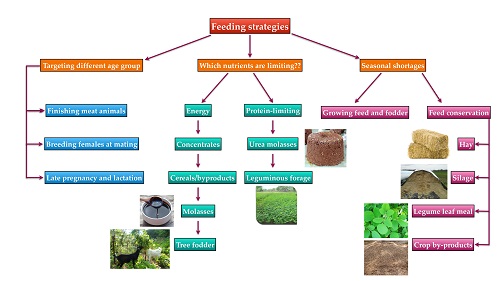
Challenges in kids rearing
Under Indian conditions, farmers encounter several challenges during kids rearing and cause substantial losses to the goat keepers. Kids being the future replacement stock of the flock, utmost care should be given to their management. The first month of kids’ life is very crucial. During this period, any abrupt change in diet, environmental conditions, or weaning stress leads to severe morbidity and mortality of young animals. Colostrum is the rich source of antibodies and other nutrients required for kids to confront pathogens until their immune system becomes fully functional.
Nevertheless, improper colostrum feeding leads to weak immunity. Consequently, it causes dysbiosis or dominance of harmful bacteria in the gastrointestinal tract, which results in diarrhea. Researchers have reported that around 30% of the kids’ mortality is due to diarrhea and pneumonia (Kumar et al., 2003). This hamper both milk and feed intake, which results in poor growth rate and low feed conversion efficiency. It is finally leading to delayed maturity and lower weight gain. Hence, there is a need to optimize the plane of nutrition in the initial weeks of kids’ lives that will positively impact growth and productivity later in life.
Constraints of Goat farming
In the present scenario, goat production faces diverse challenges and multifaceted limitations, viz., deficiency of feed and fodder, dwindling of grazing land, and rapid degradation of natural resources. Of note, increasing the stocking rate within the limited space available adversely affects goat productivity. Research findings reveal that improper feeding is the key factor hampering the milk and meat production of goats. Besides, harsher environmental conditions like rising temperature, limited availability of feed and water, and drought conditions often result in altered productivity; these traits are linked to different gene expressions under changing climatic conditions. Significant constraints concerning enhancing goat productivity are given in Figure 2, which need to be addressed immediately.
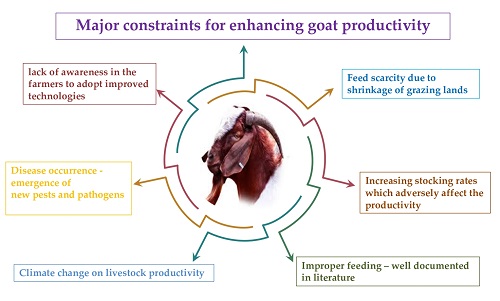
Precision nutrition concept
Precision feeding is defined as “Providing the animal with the feed that precisely meets its nutritional requirements for optimum production efficiency to produce better quality animal products”. It is a well-adapted concept in western countries, where animals eat to perform to their highest potential and maintain to be healthy. Hence, it serves as a tool for effective utilization of available feed resources to maximize the animal’s response to nutrients for economic production.
Objectives of the precision nutrition include
- Precisely meeting the nutrient requirement of livestock
- Enhanced efficiency of livestock production
- Reduced environmental pollution
- Improve nutrient utilization
- Reduce feeding cost
- Reduce feed refusal by livestock
- Reduce nutrient excretion in feces and urine
- Reduce labour cost
- Increase overall profit
Tools to achieve precision animal nutrition
Further opportunities to improve nutritional strategies for sustainable goat farming requires specific tools, which are discussed as follow:
Feed processing techniques: It includes techniques like grinding, pelleting. The feed should be ground to uniform particle size (600 µm) and subsequently improves nutrient utilization. Particle size reduction plays an essential role in enhancing digestibility, better feed conversion efficiency, and increased the growth rate of kids. Pelleting of diets is an effective way to improve feed efficiency (generally 4 to 6 %) for all phases of goat production. One of the studies highlights that feeding pellets decreased DM excretion (23%) reduced N excretion (22%), improved feed efficiency (6.6%), and reduced feed waste (up to 5 %).
Strategic supplementation of critical nutrients: Some nutrients are required in very minute amounts, especially mineral mixture and vitamin premix. Nevertheless, their presence in the diet is essential for optimum production. During critical developmental time windows, specific nutrient supplementation (e.g., AA, iodine, fats, vitamins, minerals) has influenced key performance traits such as lactation, reproduction, lamb survival, and lamb growth. However, sometimes nutrients may be present in sufficient amounts in the diet, but the animal may suffer from deficiency diseases and cannot utilize them efficiently. This may be due to
a) Absence of enzyme in animal to break down of feed and utilize that particular nutrient e.g., Lignified cellulose, Phytin phosphorus
b) Antagonistic interaction of nutrients among themselves e.g., Copper – Zinc mineral interaction (bioavailability decreases)
c) Parasitic infestation also decreases voluntary feed intake, absorption of nutrients e.g., Stomach worms, Liver flukes, and intestinal parasites
Precise ration formulation: many nutritionists proposed that the success of the livestock sector lies in devising a cheap and efficient ration. For few years, concern has been raised over the irrational use of hormones and antibiotics in food animals to boost production and their deleterious effects on consumers due to their residues. Hence, a modern animal nutritionist must develop rations without antibiotics, hormones, meat and bone meals, and other objectionable feed ingredients, which cause a hazard to both animal and human health and cause substantial economic loss. Even though it is challenging for the animal nutritionist to formulate rations that can produce animal products that are acceptable to the consumer and do not cause environmental pollution, maintain animal health, and remain economically viable. Ration must be balanced and palatable for the animals.
Implementing different feeding methods
- Phase feeding: To optimize the production and minimize nutrient waste, the animal’s diet should be changed continuously to match its requirements. It involves formulating and providing more special rations during growth-specific periods. Phase feeding programs match the animal’s nutrient requirements as they change with age or size and reduce the excessive amount of nutrients. Advantages include – improved performances, better economic return; less feed storage is required; reduces nitrogen and phosphorus excretion.
- Split-sex feeding: Dividing the animals according to gender so that diets can be formulated to meet the unique nutrient needs of each sex. In this system, animals of the same gender are kept together, i.e., feeding males and females separately.
- Dynamic feeding: In this type, concentrate ration mainly pays attention because concentrate requirement varies highly with animal production level. Concentrate feed management also affect feed input cost. The milk yield response of lactating goats increases with concentrate intake. This feeding system helps to reduce unnecessary extra concentrate feeding in late lactation.
- Use of feed additives: Feed additives are provided to the animal to enhance the effectiveness of nutrients, increase digestibility, and exert their beneficial effect on the gut (Table 1).
Table 1: List of feed additives available for application in feed and their benefits
| S. No. | Feed additives | Benefits of feeding |
| 1. | Aspergillus oryzae (Yeast) | Stimulate fibre-digesting bacteria, stabilize rumen pH, and reduce heat stress |
| 2. | Calcium propionate | Increase blood glucose and calcium levels |
| 3. | Protected choline | A methyl donor used to minimize fatty liver formation and to improve fat mobilization |
| 4. | Enzymes | Increase fibre digestibility by reducing fibre (cellulase and xylanase enzymes) and DM intake |
| 5. | Magnesium oxide | Alkaxlinizer (raising rumen pH) and increases uptake of blood metabolites by the mammary gland, raising fat test |
| 6. | Methionine hydroxy Analog | Minimize fatty liver formation, control ketosis, and improve milk fat test |
| 7. | Probiotics | Produce metabolic compounds that destroy undesirable organisms. Probiotics provide enzymes improving nutrient availability, or detoxify harmful metabolites |
| 8. | Propylene glycol | Used as a source of blood glucose, to stimulate an insulin response, and to reduce fat mobilization |
| 9. | Sodium bentonite | Clay mineral used as a binder, which shifts VFA patterns, slows rate of passage, and exchanges mineral ions. Field claims to tie up mycotoxins have been reported |
| 10. | Sodium bicarbonate / Sodium sesquicarbonate (Buffer) | Increase dry matter intake and stabilize rumen pH |
| 11. | Yucca extract | Decrease urea nitrogen in plasma and milk by binding ammonia to the glycofraction extract of Yucca shidigera plant, improving nitrogen efficiency in ruminant animals |
| 12. | Zinc methionine | To improve immune response, harden hooves, and lower somatic cell counts |
Advantages
- It enhances the feed intake of animals by using feed grade flavoring agents
- Helps in digestion of feeds (enzymes – xylanase, cellulase, pectinase, etc.)
- Helps in absorption nutrients using chelating agents or organic minerals
- Alter metabolism of the host by oral administration of probiotics, prebiotics
- Enhance growth and production of animals.
- Reduce methane production, saves energy, reduce environmental pollution—bromochloromethane (halogenated methane analog), organic acid (alternate hydrogen sink)
Systematic manipulation of metabolism: For systematic manipulation of metabolism, understanding of biological processes in GIT, i.e., digestion, absorption, and utilization of nutrients, is essential. The more profound knowledge of biological processes and biotechnological interventions like nutrigenomics studies helped us to understand strategies and feed conversion efficiency at the genetic level. Rumen microorganisms play essential roles in the utilization of nutrients. We must study rumen processes carefully, then only we will be able to apply some biotechnological tools to achieve precision animal nutrition. So that we can modulate the rumen microbiome for better yield through bacterial community design.
Economic efficiency of precision nutrition
- Precision Feed Systems is the industry leader in feed automation, improves feed efficiency and shrink reduction of input cost
- Reduces nutrient excretion
- Reduces feed loss (up to 10%)
- Decreases feed costs (up to 15 %)
- Speedy return on investment (ROI)
- Reduces labor cost
- Enhances overall profit of the farmers
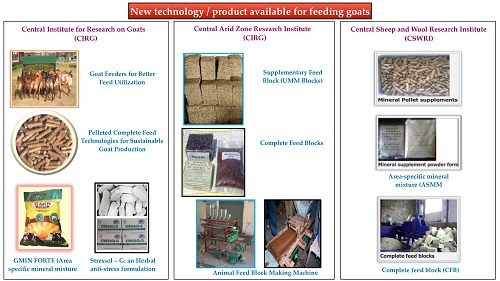
For enhancing productivity, improving the reproduction and health of goats, renowned institutes have developed recent technologies and products. These can be applied at the field level, which is economical, viable, and eco-friendly.
- Central Institute for Research on Goats (CIRG)
- Goat feeders for better feed utilization
- Pelleted complete feed technologies for sustainable goat production
- Stressol – G: an herbal anti-stress formulation
- GMIN FORTE – area specific mineral mixture for Uttar Pradesh
- Central Arid Zone Research Institute (CAZRI)
- Supplementary feed block (urea molasses mineral blocks):concentrated source of energy, protein, and minerals fulfilling area-specific nutrient needs of animals.
- Complete feed blocks:A proportioned mixture of locally available fodder and concentrates on meeting the total nutritional needs of animals. It is sold at Rs. 8 per kg.
- Animal feed block-making machine:About 40 feed blocks per hour can be prepared with this unit.
- Central Sheep and Wool Research Institute (CSWRI)
- Area-specific mineral mixture (ASMM): For cattle, buffaloes, sheep, and goats of the semi-arid region of Rajasthan have been developed for improving health, reproduction, and production level.
- Complete feed block (CFB): Use of feed block to sheep and goats reduces the cost per kg gain by 38% compared to the control diet (grass hay and concentrate).
Thrust area for future exploration and proposed action
- Omics techniques– optimizing productive and reproductive performance using omics approaches, identifying novel biomarkers for stress management.
- Methane mitigation– to address the issue of climate change, which is the need of the hour. The use of potent feed additives and proper feeding measures to modulate rumen fermentation should be taken to mitigate greenhouse gas emissions.
- Rumen microbiology and biotechnology– exploring these fields and applying rumen microbes as direct-fed microbial (DFM) lead to value-added animal production.
Conclusion
There are various tools and techniques available for goat farmers to improve nutrition and increase productivity and efficiency, and more are being developed. Implementation of precision nutrition for maximizing efficient utilization of feeds needs to be established in goats. Match animals’ requirement to the nutrient value of locally available feed resources. Using an area-specific mineral mixture, we can provide minerals that are deficient in a specific area and alleviate reproduction problems. Overall, enhance the profitability of the farm in an eco-friendly manner. However, the ability of farmers to obtain information from credible sources and adapt the information to their unique circumstances remains critical to the implementation of these technologies. Continued efforts are needed to ensure that prospective trainers are familiar with both current and future technology.
References
- Giger-Reverdin, S., Domange, C., Broudiscou, L.P., Sauvant, D. and Berthelot, V., 2020. Rumen function in goats, an example of adaptive capacity. Journal of Dairy Research, 87(1), 45-51.
- Kumar, S., Vihan, V.S. and Deoghare, P.R., 2003. The economic implication of diseases in goats in India with reference to implementation of a health plan calendar. Small Ruminant Research, 47(2), 159-164.
- McCoard, S.A., Stevens, D.R. and Whitney, T.R., 2020. Sustainable sheep and goat production through strategic nutritional management and advanced technologies. In Animal Agriculture(pp. 231-246). Academic Press.
- Morand-Fehr, P., 2005. Recent developments in goat nutrition and application: A review. Small ruminant research, 60(1-2), 25-43.
- Sahoo, A. and Karim, S.A., 2010. Sheep and goat nutrition: newer concepts and emerging challenges. Indian Journal of Small Ruminants, 16(1), pp.18-28


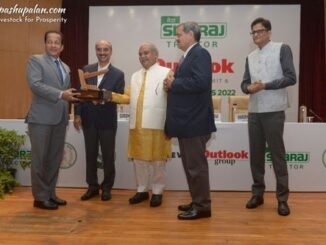

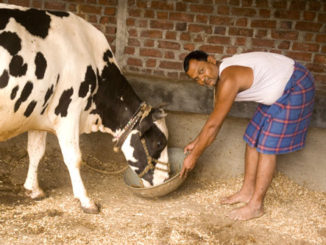

Be the first to comment